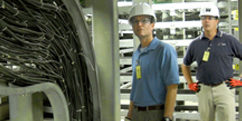
 Cables provide the framework for almost every piece of equipment required to safely and efficiently run a nuclear power plant. Every utility, not just nuclear power, relies heavily on the performance of low voltage power, instrument, and control wiring to perform daily and emergency functions. All of these utilities have locations within their facilities that are exposed to harsh environments, which can have increasing adverse impact on cable reliability as the equipment service life is stretched with plant life extensions. In addition, inaccessible cable trays, underground conduits, and underground duct banks make inspections and replacements time consuming and costly.
Cables provide the framework for almost every piece of equipment required to safely and efficiently run a nuclear power plant. Every utility, not just nuclear power, relies heavily on the performance of low voltage power, instrument, and control wiring to perform daily and emergency functions. All of these utilities have locations within their facilities that are exposed to harsh environments, which can have increasing adverse impact on cable reliability as the equipment service life is stretched with plant life extensions. In addition, inaccessible cable trays, underground conduits, and underground duct banks make inspections and replacements time consuming and costly.
Recently, a team of engineers at AMS consulted with Oyster Creek Nuclear Generating Station, a boiling water reactor power plant in New Jersey, which had been experiencing numerous low voltage cable degradation issues, some of which had significant impact to the plant’s operational status and efficiency. In response, the AMS team working with Oyster Creek personnel developed an effective strategy to address the aging of low voltage cables in known adverse environments throughout the plant. The tests were performed by AMS with minimal impact on the cables and associated systems while still providing useful information on cable insulation aging and operational status. This test method developed at AMS uses an innovative approach that compares the results of a non-destructive, in-situ electrical test with existing laboratory analyses to identify, locate, and quantify impedance changes in cable circuits throughout the plant.
 With the incorporation of this innovative testing methodology, the potential exists for assessing low voltage cables throughout the plant with minimal impact on normal plant operation, plant refueling outage durations, and/or equipment unavailability time. As such, the team at Oyster Creek successfully tested and inspected the cables, recommended repair/replacement actions to outage management, and implemented those actions with increased efficiency, taking only 4 days as opposed to the 14 originally required for conventional testing methods.
With the incorporation of this innovative testing methodology, the potential exists for assessing low voltage cables throughout the plant with minimal impact on normal plant operation, plant refueling outage durations, and/or equipment unavailability time. As such, the team at Oyster Creek successfully tested and inspected the cables, recommended repair/replacement actions to outage management, and implemented those actions with increased efficiency, taking only 4 days as opposed to the 14 originally required for conventional testing methods.
The implementation of this new approach to increasing low voltage cable reliability promotes a strong nuclear safety culture. Identifying and eliminating unnecessary risks to safe, continuous nuclear plant operation is essential to demonstrate the positive influence of nuclear generation in the power industry. In addition, it provides an additional predictive monitoring technique that can be used to support cable aging management programs and extension of plant operating licenses. These benefits help promote confidence in nuclear power plant operation through control of aging mechanisms for such a widely used, and critical, type of equipment.








